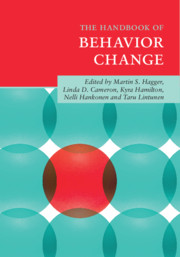Book contents
- The Handbook of Behavior Change
- The Handbook of Behavior Change
- Copyright page
- Dedication
- Contents
- Figures
- Tables
- Sidebars
- Contributors
- 1 Changing Behavior: A Theory- and Evidence-Based Approach
- Part I Theory and Behavior Change
- Part II Methods and Processes of Behavior Change: Intervention Development, Application, and Translation
- Part III Behavior Change Interventions: Practical Guides to Behavior Change
- 31 Attitudes and Persuasive Communication Interventions
- 32 Self-Efficacy Interventions
- 33 Imagery, Visualization, and Mental Simulation Interventions
- 34 Affect-Based Interventions
- 35 Autonomy-Supportive Interventions
- 36 Incentive-Based Interventions
- 37 Monitoring Interventions
- 38 Goal Setting Interventions
- 39 Planning and Implementation Intention Interventions
- 40 Self-Control Interventions
- 41 Habit Interventions
- 42 Economic and Behavioral Economic Approaches to Behavior Change
- 43 Dyadic Behavior Change Interventions
- 44 Social Identity Interventions
- 45 Motivational Interviewing Interventions
- 46 The Science of Behavior Change: The Road Ahead
- Index
- References
33 - Imagery, Visualization, and Mental Simulation Interventions
from Part III - Behavior Change Interventions: Practical Guides to Behavior Change
Published online by Cambridge University Press: 04 July 2020
- The Handbook of Behavior Change
- The Handbook of Behavior Change
- Copyright page
- Dedication
- Contents
- Figures
- Tables
- Sidebars
- Contributors
- 1 Changing Behavior: A Theory- and Evidence-Based Approach
- Part I Theory and Behavior Change
- Part II Methods and Processes of Behavior Change: Intervention Development, Application, and Translation
- Part III Behavior Change Interventions: Practical Guides to Behavior Change
- 31 Attitudes and Persuasive Communication Interventions
- 32 Self-Efficacy Interventions
- 33 Imagery, Visualization, and Mental Simulation Interventions
- 34 Affect-Based Interventions
- 35 Autonomy-Supportive Interventions
- 36 Incentive-Based Interventions
- 37 Monitoring Interventions
- 38 Goal Setting Interventions
- 39 Planning and Implementation Intention Interventions
- 40 Self-Control Interventions
- 41 Habit Interventions
- 42 Economic and Behavioral Economic Approaches to Behavior Change
- 43 Dyadic Behavior Change Interventions
- 44 Social Identity Interventions
- 45 Motivational Interviewing Interventions
- 46 The Science of Behavior Change: The Road Ahead
- Index
- References
Summary
Mental imagery is defined as the mental representation of future events, actions, or tasks. Imagery techniques have been frequently used as means to change behavior. Numerous strategies have been used including guided imagery, mental simulations, and functional imagery training. Several theories explain how mental imagery may change behavior, including social cognitive, emotion regulation, and elaboration intrusion theories. Key mediators of imagery interventions include self-efficacy and outcome expectancies, emotion regulation, cue accessibility, and desires and intrusive thoughts. Imagery interventions are effective in changing behavior, typically with small-to-medium effect sizes. Imagery interventions are more effective in older populations, when detailed instructions are provided, and if they are longer in duration. Practitioners considering using imagery to change behavior should consider (1) imagery intervention content and format; (2) selection of the appropriate target audience; (3) identification of means to promote imagery intervention effectiveness; (4) identification of training and skills required for the type of imagery; (5) the appropriate dose of imagery; (6) inclusion of methods to evaluate imagery intervention fidelity; and (7) means to evaluate the efficacy and theory-based processes of imagery interventions. More high-quality experimental and intervention research evaluating imagery techniques on behavior change in diverse behaviors, contexts, and populations is required.
Keywords
- Type
- Chapter
- Information
- The Handbook of Behavior Change , pp. 479 - 494Publisher: Cambridge University PressPrint publication year: 2020



